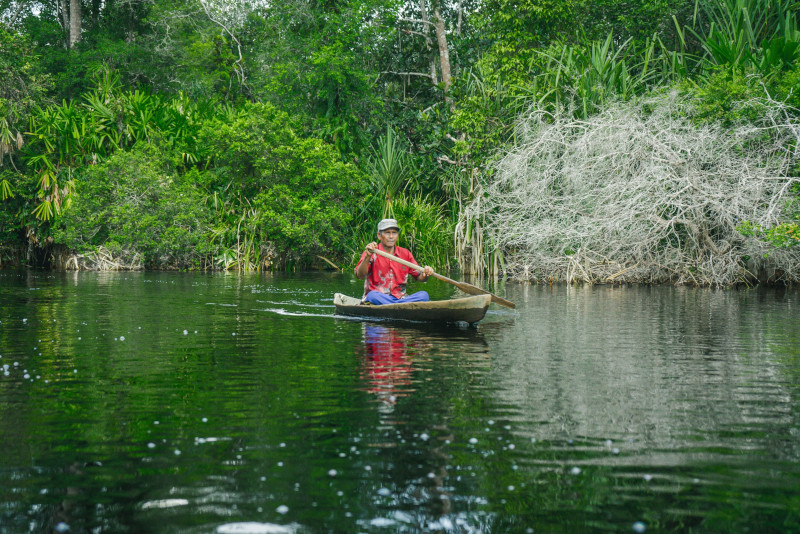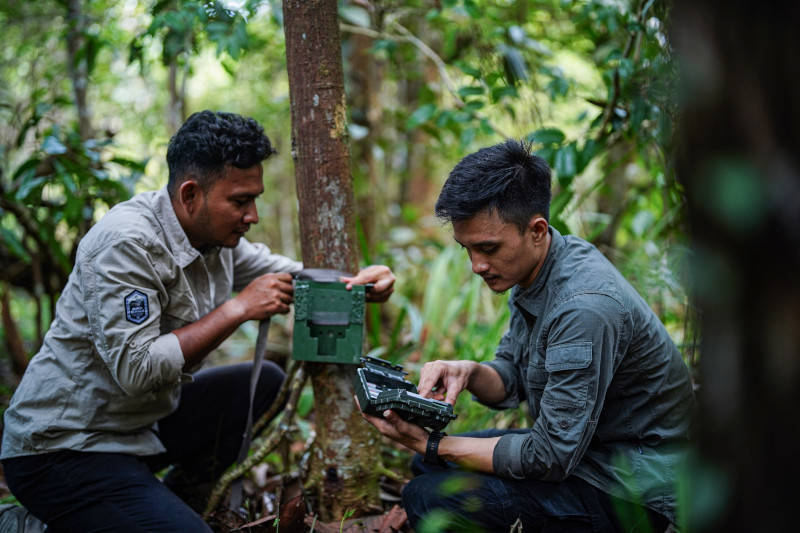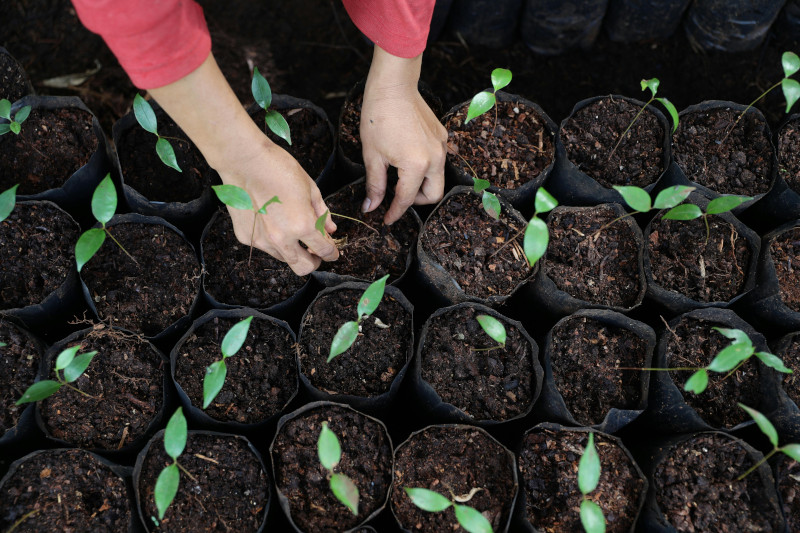August 28, 2025
Each year, Restorasi Ekosistem Riau (RER) publishes its Progress Report to share milestones, research findings, and community initiatives from across its 150,000 hectares of tropical peat swamp forest in Sumatra. The 2024 edition highlights new biodiversity discoveries, innovative restoration methods, and strengthened partnerships with local communities.
This year’s progress report is especially significant. It reflects on over a decade of progress and impact across the Kampar Peninsula and Padang Island, demonstrating how RER’s production-protection model delivers long-term results for nature, climate, and people.
In this article, we present five key highlights from the report.
1. First Comprehensive Camera Trap Survey on Padang Island
In 2024, RER completed the first systematic camera trap survey on Padang Island, a remote and largely understudied ecosystem. A total of 58 cameras, deployed over an area of 20,599 hectares, recorded 17 mammal species, 2 birds, and 1 reptile. Among these were the Critically Endangered sunda pangolin (Manis javanica) and the East Sumatran banded langur (Presbytis percura).
The survey also revealed 14 instances of human presence, pointing to risks of poaching. These findings will help guide future protection strategies. The baseline data from these surveys will be published in 2025 as part of RER’s scientific series.
This work underscores the importance of long-term monitoring. Baseline studies on Padang Island will allow conservation teams to track changes in wildlife populations over time, ensuring management decisions are rooted in evidence and guided by the latest data.

2. Assessing Mammal Conservation in the Human-Modified Landscapes of Sumatra
A landmark PhD study by Dr Irene Margareth Romaria Pinondang of the University of Kent examined the status of medium- to large-sized mammals in Sumatra’s peat swamp landscapes. Using over 200 camera traps across plantations, riparian corridors, and core peat forests, her research found that mammal diversity remains surprisingly high in production landscapes when linear forest remnants and core areas are maintained.
Dr Pinondang concluded:
“Within the context of our study, the landscape configuration adopted by the dominant private entity—preserving core forest integrity and maintaining linear forest remnants—demonstrates how such site-specific strategies can provide critical areas to harness biodiversity conservation.”
Even the Critically Endangered Sumatran tiger (Panthera tigris sumatrae) was recorded more often in plantations than in core forest, likely because prey such as wild boar and deer are more abundant in open areas. Over seven years of monitoring, the mammal community showed a tendency to increase, reflecting the positive impact of RER’s restoration efforts.
This research highlights that ecosystem restoration concessions (ERCs) like RER can function as Other Effective Area-Based Conservation Measures (OECMs), contributing to biodiversity protection beyond formally protected areas.

3. Completion of the First Odonata Surveys on the Kampar Peninsula
For the first time, RER completed a multi-year survey of Odonata—dragonflies and damselflies—on the Kampar Peninsula. Led by Dr Rory A. Dow, an IUCN Odonata Specialist, the survey documented 100 species across 12 families, including five that had previously never been recorded in Indonesia, and one that is entirely new to science.
This discovery increased the known species count in Riau Province from 88 to 127. Nearly half of the species recorded are forest-dependent, reinforcing the ecological value of peat swamp habitats.
Because their life cycles depend on clean aquatic environments, dragonflies and damselflies are key indicators of freshwater ecosystem health. By documenting their diversity, RER has established a baseline inventory that will guide future research and conservation.
4. Innovations in Dam Construction for Peatland Restoration
Peatland restoration depends on rewetting degraded areas to prevent fires, carbon emissions, and further subsidence. Since 2016, RER has constructed 80 dams across 129 km of canals on the Kampar Peninsula, successfully rewetting 94% of drained peat forest.
In 2024, RER highlighted new engineering approaches in dam construction, including the use of felt dams and sandbag dams adapted to local hydrology. These innovations make structures more resilient against shifting soils and seasonal flooding.
By blocking canals and raising water tables, RER not only prevents fire risk but also reduces carbon emissions from peat oxidation, helping Indonesia meet its climate goals. According to the report, these efforts directly support RER’s objective of protecting 6.5 million tons of CO₂ equivalent per year.

5. Strengthening Community Collaboration in Segamai and Serapung Villages
RER’s conservation success is closely tied to its partnerships with local communities. In 2024, two initiatives stood out:
As Bey Soo Khiang, Chairman of APRIL Group and RER Advisory Board, noted:
“Our work with communities outside of RER’s boundaries is another priority… one major success in 2024 was preventing any illegal logging, which had been a major threat in previous years.”
These efforts show that conservation and community well-being are interdependent. By building trust and providing alternatives, RER helps ensure forests are protected for the long term.
Download the Full Report
These five highlights represent just a snapshot of RER’s progress in 2024. The full report covers climate monitoring, forest restoration, hydrology, youth engagement, and much more.
To explore all the findings in detail, download the RER Progress Report 2024.